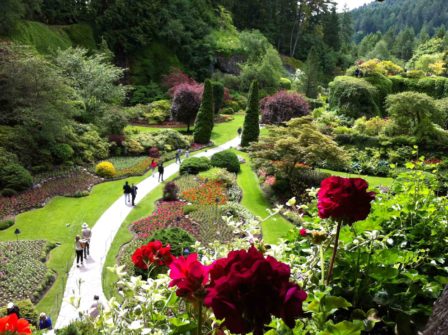For the Love of Plants

Victoria’s Butchart Gardens have provided inspiration for Bishop’s garden designs.
October’s Garden Club meeting featured a past president of San Diego Horticultural Society and our own garden club, Jim Bishop. He introduced himself as a plant-a-holic. He explained his first slide by saying he always loved to dig. There was Bishop, maybe two years old, shovel in hand at the beach in Panama City, Florida.
Born in Texas in 1955, Bishop and his family moved often, including years in several Florida towns. When they moved back to Texas, one of the first plants Bishop became aware of was tumbleweed; it was Texas after all. Bishop’s father needed to clear the tumbleweeds from the house so they could use the driveway and access the house. An imported weed like flax seed, tumbleweed came from Eurasia. It is prevalent in all the drier areas of the continental United States.
Bishop’s next significant encounter with a plant was on a family road trip to Yellowstone. When the car became stuck between two parts of a giant tree trunk, the only way Bishop’s dad could free the car was to let some air out of the tires, lowering it just enough to continue their trip! This event made quite an impression on the young man.
Apparently, he inherited his love of growing things from his mother. Since the family moved too often for her to plant slower growing species, she liked to plant opium poppies. In Houston, opium poppies and marigolds were prodigious. Sixty years later, he grows poppies from seeds saved from his mother’s garden.
Texas and Florida weren’t the only states where the Bishops lived. They moved to Kansas. Bishop’s mom planted trees in many of their homes despite knowing she would never see them mature.
Bishop probably inherited his mother’s love of plants, but his photographic and artistic talents probably came from his grandparents. His grandfather, who died when Bishop was five-years old, photographed the Ozarks while his grandmother painted and sold postcards of them at her souvenir shop in Branson, Missouri.
By the time Bishop was in high school, the family had moved to Houston. Here he attended his first garden tour, the Azalea Festival, where he met Ima Hogg, famed for her name but also for being the daughter of a wealthy Texan rubber baron, who inherited a lovely estate, which became the River Oaks Garden Club. Bishop remembers meeting her there, 93-years old, drinking sweet tea, a favorite Southern beverage. It was not until decades later, when back in Texas, that Bishop would encounter his first botanic garden as well as the Japanese garden at Zilker Park in Austin.
The University of Texas in Austin, where Bishop majored in Engineering, also impressed him. Its landscape is magnificent with Italian sculptures and buildings that have been designed to augment the landscape and vice-versa. Bishop enjoyed the wildflowers of Austin. Along a jogging trail, Bishop saw beautiful public gardens, which were planted as one of Lady Bird Johnson’s Beautify America programs. Some of the Cypress trees along Town Lake there are 800-years old.
By this time, Bishop was a young man. He was hired to work for an armored personnel carrier firm in Santa Clara, California. To him, the freeways of California looked like parkland. San Francisco’s beautiful landscape awed him. San Diego’s Vacation Village, in 1979, was a magnificent sight with plantings and sculptures making a beautiful creation.
In Santa Clara, Bishop found an apartment with a balcony. The apartment’s 600 square feet didn’t faze him; he had a good-sized balcony with views of the Santa Clara Mountains, and ponds festooned with black swans. Best of all, he could grow plants. He filled the balcony with so many plants that after a year, the balcony, weakened by the weight of Bishop’s garden, fell off!
The Santa Clara Valley is, according to Bishop, the richest and most productive land in the world. Sadly, it is now all houses and businesses. In nearby Capitol, in its heyday, the tuberous begonia blossoms grown there were stripped from the plants and made into incredible parade floats.
Eventually Bishop transferred to San Diego with a software company owned by G.E. Here he bought a home in Encinitas, which he was too cash poor to landscape. On a family vacation to the Pacific Northwest, they visited Butchart Gardens in Victoria. He mentioned Bellingham, Washington, known for its gardens and a terrific climate for plants. Returning home, he realized he could plant large beds of plants grown from seed to recreate the large flower quilt of Butchart Gardens. Fourteen years later and countless changes in plant tastes, he had created a floral fantasy.
In 1994 he attended the first meeting of the San Diego Horticultural Society. Through the society he met many fellow plant-a-holics and toured countless local gardens. He recently completed being San Diego Horticultural Society president for six-plus years.
For the past 20 years, he has lived on a canyon in North Mission Hills with Scott Borden, his partner, who he met through a local gardening group. They removed the swimming pool, built a casita (a garden room) and have created an incredible setting of succulents, pathways, mosaic tiled areas influenced by trips to England, Spain, Mexico and other gardens around the world. The property is actually run by Gracie and Stanley Borden-Bishop, extremely intelligent and beautiful cats, with Jim Bishop and Scott Borden executing their every wish.
The January 24, 2019 Garden Club meeting will feature Lee Somerville, whose topic is Potatoes, Petunias, and Patriotism: San Diego’s Victory Garden. It will be held at the church at 4070 Jackdaw from 6 to 8 p.m
Category: Education, Local News, National News







